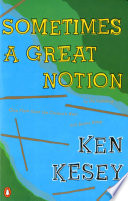Estimated read time: 5 min read
One Sentence Summary
Family dynamics and the clash between individualism and unionization take center stage in this multi-generational tale set against the backdrop of the Pacific Northwest timber industry.
Table of Contents
Introduction
"Sometimes a Great Notion" is a powerful and complex novel written by Ken Kesey, the acclaimed author of "One Flew Over the Cuckoo's Nest." Published in 1964, this book explores themes of individualism, family dynamics, and the struggle between progress and tradition. Set in the Pacific Northwest, the novel takes readers on a compelling journey through the lives of the Stamper family, who are loggers fighting to maintain their independence in the face of external pressures.
Brief Synopsis
The book is set in a small logging town in Oregon during the early 1960s. The Stamper family, consisting of Hank Stamper, his half-brother Leland Stamper, and their father Henry Stamper, owns a logging business that has been in their family for generations. The logging industry is facing significant changes as a labor dispute between workers and the local union escalates.
The story kicks off when Hank, the novel's protagonist, receives news of his estranged half-brother Leland's return. Leland, known as "Lee," is an Ivy League-educated intellectual who had left the family business years ago but has now returned with the intention of helping the family with their logging operation. This sparks tension within the family, as Hank resents Lee and their shared past.
The Stamper family lives in a large, isolated house that overlooks the river. They are deeply isolated from the rest of the town and have an intense sense of pride in their autonomy. As the labor dispute worsens, the Stampers refuse to go on strike like other loggers in the area, causing further animosity between them and the rest of the community.
With its unique narrative structure, the novel alternates between different characters' perspectives, including Hank, Lee, and other significant figures in the town. These shifts in narrative voice provide insights into the complexities of individual motivations, family dynamics, and the larger societal tensions at play.
Main Events
The novel is filled with dramatic events that shape the lives of the characters and propel the story forward. Some of the main events include:
- Lee's return to the Stamper family and his attempts to reconcile with Hank while serving as a catalyst for further conflicts.
- The logging industry's labor dispute and the divisiveness it creates within the community, with the Stampers adamantly opposing the strike.
- The unveiling of hidden family secrets, including the truth behind the death of Hank's and Lee's mother, which adds another layer of tension to the story.
- The constant struggle with the harsh natural environment, including flooding and dangerous working conditions in the logging camps.
- Romantic entanglements between the characters, particularly Lee's relationship with Viv, a married woman, which further complicates the already strained family dynamics.
Main Characters
Hank Stamper: The central protagonist of the novel, Hank is a rugged and determined logger who is fiercely loyal to his family and their logging business. He is stubborn and resents his half-brother Lee for leaving the family years ago.
Leland Stamper: Often referred to as Lee, he is Hank's educated and intellectual half-brother who returns to the family business. Lee struggles with feelings of alienation and a desire to belong.
Henry Stamper: Hank and Lee's father, Henry is an aging patriarch who has devoted his life to the logging business. He is proud and set in his ways, refusing to conform to societal expectations.
Viv: A married woman with whom Lee develops a romantic relationship, Viv serves as a catalyst for further conflicts within the Stamper family.
Themes and Insights
Individualism vs. Conformity: The novel explores the tension between individualism and societal pressure to conform. The Stamper family embodies the spirit of individualism, refusing to give in to external pressures and maintain their independence. However, this defiance comes at a cost, as they face isolation and division from the rest of the community.
Family Dynamics: Through the complex relationship between Hank and Lee, the novel delves into the complexities of family dynamics. The deep-seated resentments, secrets, and conflicting desires explored in the book shed light on the intricacies of sibling relationships and the impact of family history on individual identity.
Nature and the Environment: The harsh and unforgiving natural environment plays a significant role in the novel. Kesey vividly portrays the power of nature, its ability to shape lives, and its role in emphasizing the characters' struggle for survival and autonomy.
Change and Tradition: "Sometimes a Great Notion" grapples with the tension between progress and tradition. While the Stamper family staunchly clings to their old ways, the encroaching changes in the logging industry and society at large force them to confront the need for adaptation.
Reader's Takeaway
"Sometimes a Great Notion" offers readers a thought-provoking exploration of individualism, family, and societal pressures. The novel is an immersive journey into the complexities of human nature, highlighting the struggles and triumphs of characters who are fighting to define their own lives in the face of adversities. Kesey's vivid descriptions, multi-dimensional characters, and exploration of timeless themes make "Sometimes a Great Notion" a compelling read that leaves a lasting impression.
Conclusion
"Sometimes a Great Notion" stands as a literary masterpiece that captures the spirit of the Pacific Northwest and the human condition. Its exploration of individualism, family dynamics, and the clash between tradition and progress resonates with readers. Ken Kesey's rich storytelling and his ability to delve into the depths of his characters' motivations make this novel an unforgettable and deeply reflective reading experience.
Sometimes a Great Notion FAQ
What is the genre of 'Sometimes a Great Notion'?
The genre of 'Sometimes a Great Notion' is fiction.
Who is the author of 'Sometimes a Great Notion'?
The author of 'Sometimes a Great Notion' is Ken Kesey.
When was 'Sometimes a Great Notion' first published?
'Sometimes a Great Notion' was first published in 1964.
What is the setting of 'Sometimes a Great Notion'?
The novel is primarily set in the fictional town of Wakonda, Oregon.
What is the main premise of 'Sometimes a Great Notion'?
'Sometimes a Great Notion' revolves around the eccentric Stamper family and their struggle against the union rules of a logging company.
Are there any notable characters in 'Sometimes a Great Notion'?
Yes, some notable characters include Hank Stamper, the rugged and unconventional protagonist, and Lee Stamper, Hank's half-brother, who brings conflict to the family.
Is 'Sometimes a Great Notion' a sequel or part of a series?
No, 'Sometimes a Great Notion' is a standalone novel and not a sequel or part of a series.
Is 'Sometimes a Great Notion' suitable for all ages?
This book is generally recommended for mature readers due to strong language, violence, and adult themes.
Has 'Sometimes a Great Notion' been adapted into a film?
Yes, 'Sometimes a Great Notion' was adapted into a film in 1971, directed by Paul Newman, who also starred in it.
What are some similar books to 'Sometimes a Great Notion'?
Similar books in terms of themes and setting include 'To Build a Fire' by Jack London and 'Deliverance' by James Dickey.





